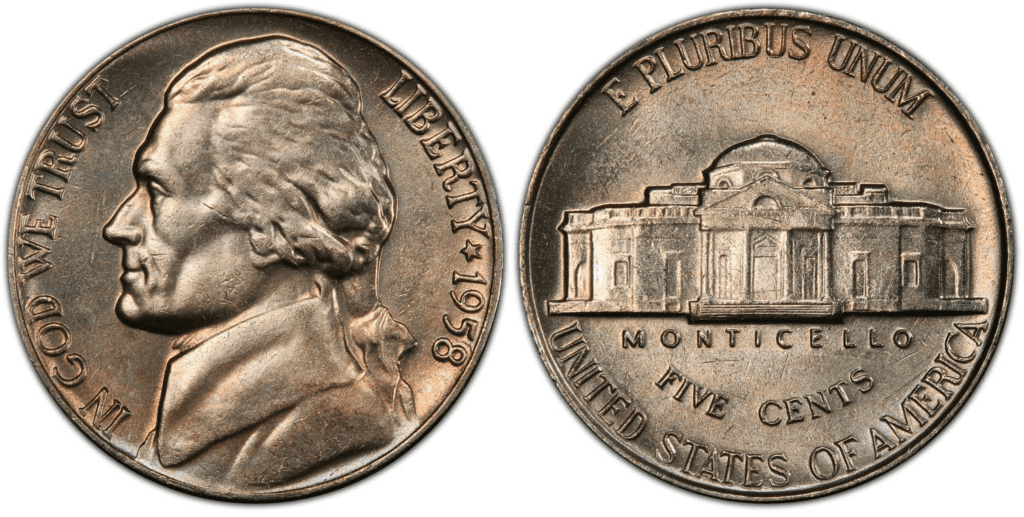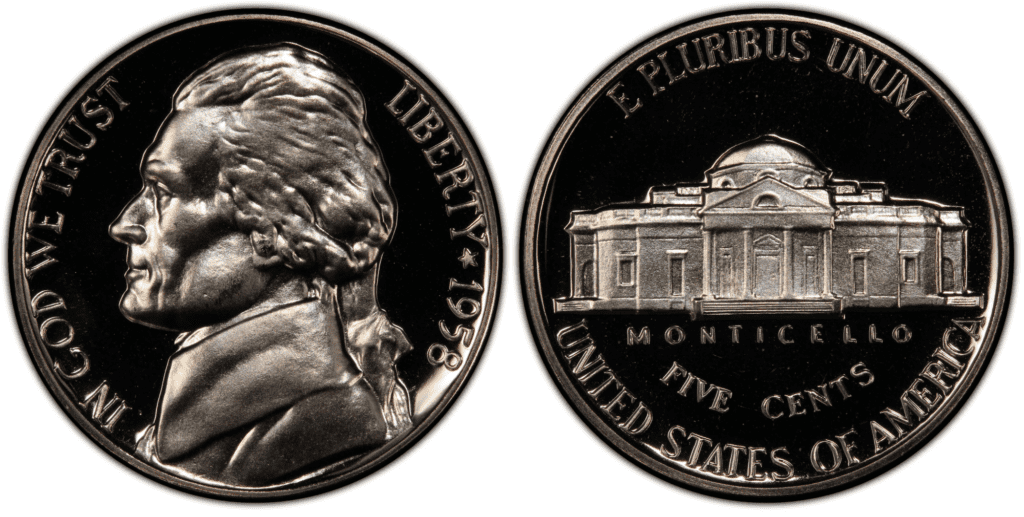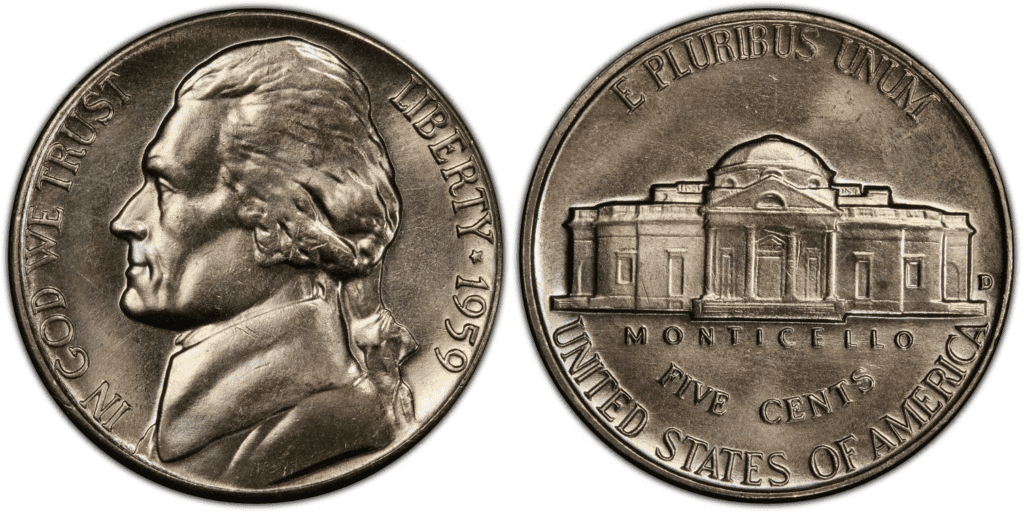What Is the 1958 Jefferson Nickel Made Of?
The 1958 Jefferson nickel is made of 75 percent copper and 25 percent nickel. It has a value of 5 cents or 0.05 US dollars, a mass of 5 grams, a diameter of 21.21 millimeters, and a plain edge.
During World War II, the Jefferson nickel was called the “Wartime Nickel.” What made it different from other series is that the US Mint changed its composition. From 75% copper and 25% nickel to 56% copper, 25% silver, and 9% manganese. The copper content was significantly decreased, and the copper amount was reduced. To make it up, silver and manganese were added.
This change is because copper and nickel were critical raw materials for developing war machinery and armament.
Felix Schlag designed the coin’s obverse after winning the design competition held by the US Mint. Although his design was chosen, the Mint still required him to make some changes.

The obverse of the 1958 nickel features the left profile of Thomas Jefferson, one of the United States’ founding fathers and the country’s third president. Inscriptions include the following:
- IN GOD WE TRUST
- LIBERTY
- 1958
The reverse of the coin is also a design made by Schlag. Although the obverse was changed in 2005, the reverse essentially stated the same except for 2004 and 2005, when the coin bore commemorative designs.
The reverse features the house and plantation of Jefferson, the Monticello, which was located in Charlottesville, Virginia. The inscription on the reverse of the coin includes the following:
- E PLURIBUS UNUM
- MONTICELLO
- FIVE CENTS
- UNITED STATES OF AMERICA
- Mint mark (if present)
The Jefferson nickel began its production in 1938, and all three mints have joined in the production. Because the Jefferson nickel was fairly new to the public, the newly designed nickel was hoarded. Even though millions have been issued, only a few were widely circulated. It was only in 1940 that it was seen more commonly in the public.
During the early years of minting, the Monticello on the reverse wasn’t properly engraved on the coin. Thus, the Mint improved the nickel’s die in the following years to add more details. One particular element of the coin’s design that was especially focused on was the steps on Monticello.
That’s why today, the sharper and more detailed the steps on the Monticello, the more expensive the coin is.
1958 Jefferson Nickel Varieties
The 1958 Jefferson Nickel comes with three main varieties: 1958 P Jefferson nickel, 1958 P Jefferson proof nickel, and 1958 D Jefferson nickel.
Aside from the standard varieties of the 1958 Jefferson nickels, some have errors in them, giving rise to a different type of coin.
Here are the 1958 Jefferson nickel varieties that you should know:
1958 P Jefferson nickel
Edge: Smooth
Mint Mark: No mint mark
Place of minting: Philadelphia
Year of minting: 1958
Face Value: $0.05 (fifty cents)
Price: $0.05 to $13 (or more)
Quantity produced: 17,088,000
Designer: Felix Schlag
Composition: 75% copper and 25% nickel
Mass: 5 grams
Diameter: 21.21 mm
Thickness: 1.95 mm

photo source: PCGS
The 1958-P Jefferson nickel was struck in the Philadelphia Mint, and there were more than 17 million coins. There’s no mint mark, and the average price ranges from $0.05 to $13.
1958 P Jefferson nickel (proof)
Edge: Smooth
Mint Mark: No mint mark
Place of minting: Philadelphia
Year of minting: 1958
Face Value: $0.05 (fifty cents)
Price: $0.05 to $30.00 (or more)
Quantity produced: 875,652
Designer: Felix Schlag
Composition: 75% copper and 25% nickel
Mass: 5 grams
Diameter: 21.21 mm
Thickness: 1.95 mm

photo source: PCGS
The 1958-P proof Jefferson nickel was also struck in the Philadelphia Mint. At the end of 1958, there were more than 870 thousand P-proof nickel coins. There’s no mint mark, and the price can start from $0.05 to $30.00.
The 1958-proof nickels are more detailed and attractive than the other coins. Also, each proof coin can be referred to as proof, cameo, deep cameo, or ultra cameo. The most detailed one is the deep cameo, which contrasts the engraved materials and the field greatly.
It’s worth noting that the 1958 proof nickels were part of the 1958 proof set issued by the US Mint. The set included the nickel and Lincoln Cent, Washington quarter, Roosevelt Dime, and Franklin half dollar.
The rarest 1958-proof nickels have PR68 condition plus a Deep Cameo rating.
1958 D Jefferson nickel
Edge: Smooth
Mint Mark: D
Place of minting: Denver
Year of minting: 1958
Face Value: $0.05 (fifty cents)
Price: $8 to $52.00 (or more)
Quantity produced: 168,249,120
Designer: Felix Schlag
Composition: 75% copper and 25% nickel
Mass: 5 grams
Diameter: 21.21 mm
Thickness: 1.95 mm

photo source: PCGS
The Denver Mint produced the highest number of mintages for the 1958 Jefferson nickel. The Mint produced more than 168 million of these coins. You’ll find the “D” mint mark between the right side of the Monticello and the edge of the coin. The average price ranges from $0.05 to $52.00.
List Of 1958 Jefferson Nickel Errors
The 1958 Jefferson nickel is no exemption when it comes to coin errors. With more than 186 million nickel coins produced in 1958, it is just a matter of time before an error can occur.
Errors can happen anywhere in the minting process. Errors can happen during cutting the planchet and striking the coin.
One example would be the “Black Beauty” error. Here’s an example:
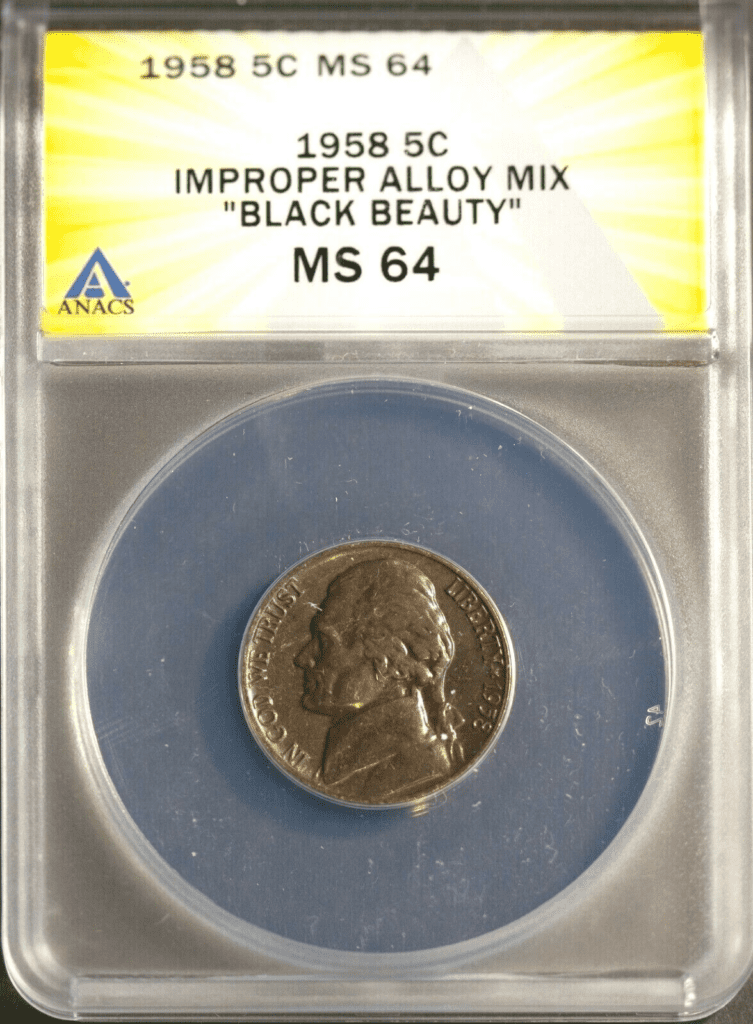
This error happens when the surface copper isn’t properly added to the planchet. As a result, the coin looks darker than usual.
Another error is the cracked die. As you can imagine, the die hits a lot of planchets multiple times at a stunning speed. With each strike, the die undergoes wear and tear. So eventually, the die breaks.
When a broken die hits the planchet, the crack on its surface also gets engraved on the coin. Here’s an example:
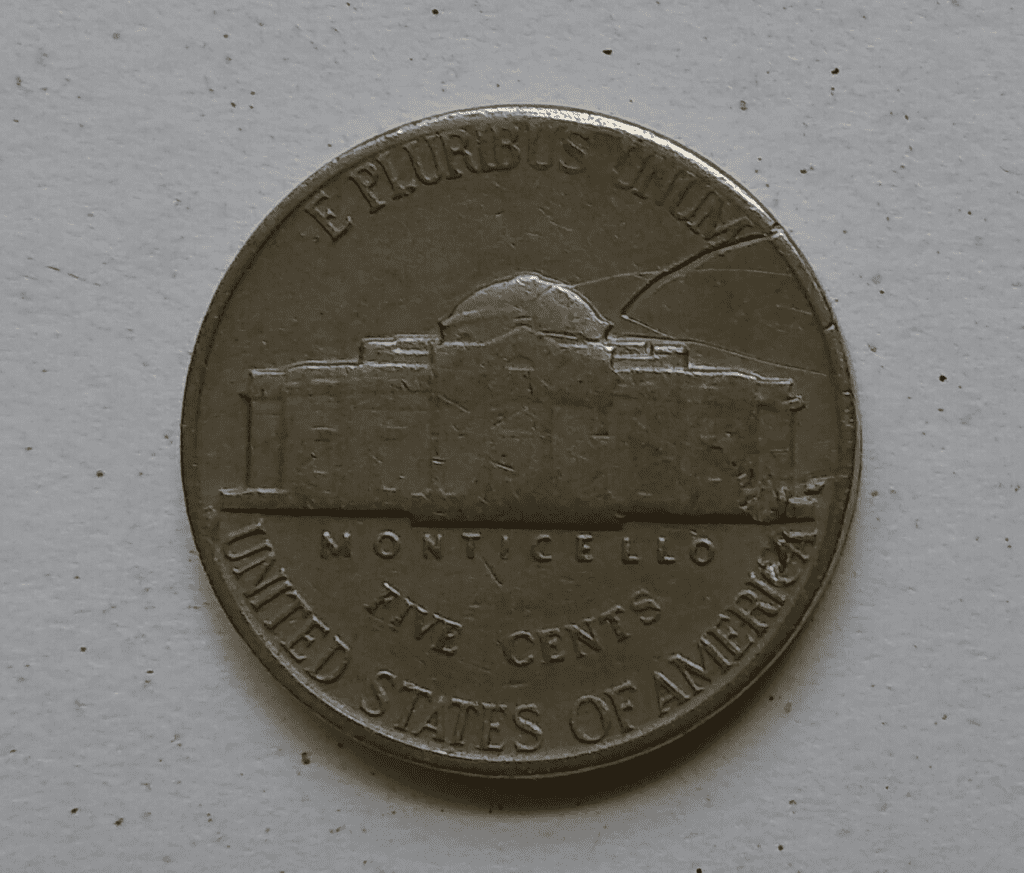
As shown above, you’ll see a curve line on the upper right side of the Monticello.
Errors can happen during strikes. For example, if the die struck the coin twice, there’s a possibility that the engraved elements would have doubled to some extent. This error is called the doubled die reverse (DDR) or doubled die obverse (DDO) error. The more obvious the doubleddie error is, the more valuable the coin.
If there’s a misalignment between the die and planchet, the 1958 nickel can have an off-center strike error. Weak strikes can also cause the coin to look smudgy.
How Much Is The 1958 Jefferson Nickel Worth Today?
As its face value shows, the 1958 Jefferson nickel is worth $0.05. The melt value is slightly higher at $0.0668.
Looking at the face value and melt value, you might think a Jefferson nickel from 1958 isn’t that valuable. However, did you know that some 1958 Jefferson 5-cent coins are worth a lot? Yes, that’s right.
To help you understand its value, here’s a 1958 Jefferson Nickel values chart:
| Coin | Condition | Grade | Mintage | Value |
| 1958 P Jefferson Nickel | Circulated/mint | Not graded | 17,088,000 | $0.05 to $13 |
| 1958 P Jefferson Nickel | Uncirculated/mint | MS-64 | 17,088,000 | $23 to $150 |
| 1958 P Jefferson Nickel | Uncirculated/mint | MS-65 | 17,088,000 | $104 to $660 |
| 1958 P Jefferson Nickel | Uncirculated/mint | MS-66 | 17,088,000 | $240 to $8,225 |
| 1958 P Jefferson Nickel (Proof) | Uncirculated/proof | Not graded | 875,652 | $7 to $52.00 |
| 1958 P Jefferson Nickel (Proof) | Uncirculated/proof | MS-67 | 875,652 | $11 to $30 |
| 1958 P Jefferson Nickel (Proof) | Uncirculated/proof | MS-68 | 875,652 | $10 to $35 |
| 1958 P Jefferson Nickel (Proof) | Uncirculated/proof | MS-69 | 875,652 | $50 to $329 |
| 1958 D Jefferson Nickel | Circulated/mint | Not graded | 168,249,120 | $8 to $16.00 |
| 1958 D Jefferson Nickel | Uncirculated/mint | MS-65 | 168,249,120 | $10 to $38 |
| 1958 D Jefferson Nickel | Uncirculated/mint | MS-66 | 168,249,120 | $13 to $94 |
| 1958 D Jefferson Nickel | Uncirculated/mint | MS-67 | 168,249,120 | $125 to $999 |
As you can see, some nickels are worth more than their face value. Notice the auction record for the 1958 P nickel is $13,513. It has a grade of MS66+FS, sold in December 2019 by Legend Rare Coin Auctions.
The 1958-proof nickel coin has an auction record of $10,869. It has a PR69DCAM grade and was sold in September 2021 by the same auction. Finally, the 1958 D nickel has an auction record of $6,325.
How Does The Grading System Work?
The Sheldon Scale is used by numismatists to provide a numerical value to coins. The Sheldon Scale goes from poor (P-1) to perfect mint state (P-1) (MS-70). Coins were originally evaluated using words to reflect their condition (Good, Fair, Excellent, Etc.). Unfortunately, coin collectors and dealers had different ideas about what each of these terms represent.
Professional numismatists joined together in the 1970s and established CoinGrading standards. These numismatists now assign grades at key places on the seventy-point scale, using the most regularly utilized numeric points in conjunction with the original adjective grade. The following are the most common coin grades:
-
-
- (P-1) Poor – Indistinguishable and probably damaged; if used, must have a date and mintmark; otherwise, rather battered.
- (FR-2) Fair – Nearly smooth, but without the damage that a coin graded Poor often possesses. The coin must have enough detail to be identified.
- (G-4) Fair – Inscriptions have merged into the rims in some areas, and important elements have been mostly erased.
- (VG-8) Very Good- A little weathered, but all of the primary design elements are visible, albeit faintly. There is little if any, central detail left.
- (F-12) Good – The item is very worn, yet the wear is even, and the overall design details stand out clearly. Rims are almost completely isolated from the field.
- (VF-20) Very Fine – Moderately weathered, with some finer features still visible. The motto or all letters of LIBERTY are readable. Both sides of the coin have entire rims that are separated from the field.
- (EF-40) Extremely Fine – Gently used; all gadgets are visible, and the most important ones are bold. The finer details are bold and clear, however, light wear may be seen.
- (AU-50) Uncirculated – Slight evidence of wear on the coin’s design’s high points; may have contact marks; eye appeal should be adequate.
- (AU-58) Uncirculated Choice – Slight traces of wear, no severe contact marks, almost full mint shine, and great eye appeal.
- (MS-60) Mint State Basal – Strictly uncirculated; no indication of wear on the coin’s highest points, but an unsightly coin with reduced luster, visible contact marks, hairlines, and other flaws.
- (MS-63) Mint State Acceptable – Uncirculated, but with contact scratches and nicks, little reduced shine, but otherwise appealing appearance. The strike is weak to average.
- (MS-65) Mint State Choice – Uncirculated with great mint shine, very little contact blemishes, and exceptional eye appeal. The strike is unusually severe.
- (MS-68) Mint State Premium Quality – Uncirculated with superb luster, no obvious contact marks to the naked eye, and exceptional eye appeal. The strike is quick and appealing.
- (MS-69) Almost Perfect Mint State – Uncirculated with perfect brilliance, a sharp and appealing strike, and extremely good eye appeal. A near-perfect coin with minor imperfections in the planchet, strike, and contact markings (seen only under 8x magnification).
- (MS-70) Mint State Perfect – Under 8x magnification, there are no tiny imperfections discernible; the strike is crisp, and the coin is perfectly centered on a beautiful planchet. Rarely seen on a coin, this coin is bright and whole, with original luster and exceptional eye appeal.
-
Where To Buy Or Sell 1958 Jefferson Nickel?
The fastest way to check places where to buy or sell 1958 Jefferson nickel would be on the Internet. A quick Google search will show you thousands of helpful links.
You can directly visit Amazon or eBay. These online marketplaces allow you to buy and sell 1958 Jefferson 5-cent coins. You can also try social media platforms such as Facebook’s Marketplace.
Moreover, you can visit websites specializing in buying or selling old coins. These include Coin Appraisers, USA Coin Book, JM Bullion, and Grey Sheet.
Aside from the Internet, there are offline sources you can go to. Coin shops, antique stores, pawnshops, and auction houses would be some of your options.
FAQs
Is a 1958 nickel rare?
1958 nickels in circulated condition are not rare. The US Mint produced more than 186 million of them. Nevertheless, 1958 nickels with a grade of at least MS67 or PR67 are rare because only a few of them exist. Aside from that, coins with errors can also be considered rare because of their uniqueness.
How much is the 1958 D black beauty nickel worth?
Depending on their condition, 1958 D black beauty nickels can be sold or bought for $2 to $20. Some might be sold for a higher price, especially if it is still in Mint State.
Where is the mint mark on a 1958 Jefferson nickel?
The mint mark on a 1958 Jefferson nickel is on the reverse side of the coin. Look at the space between Monticello’s right side and the coin’s edge. You’ll find a small “D,” which indicates the coin was struck in the Denver Mint.

